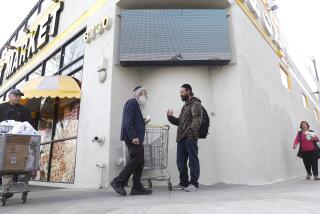Some strong memories of L.A.
Re “227 candles for L.A.,” editorial, Sept. 4
Although it may be true that many of L.A.’s old neighborhoods have been torn down, it is untrue that current or previous generations have not taken notice.
Heritage Square Museum, itself a product of a fight to save historic structures from demolition, hosted the first L.A. Heritage Day in March, when 44 history and preservation-based organizations came together to say “enough is enough.” More than 300 people came to find out more about the history that so many claim does not exist in Los Angeles. The Los Angeles Conservancy has one of the largest memberships in the country. These things could not exist if Angelenos did not care about the history of their town. You can be sure there are people working together so that when the next Ambassador Hotel is about to be torn down, it will be one heck of a fight.
Brian Sheridan
Los Angeles
The writer is the director of development at the Heritage Square Museum.
--
When my adventurous father decided to move here from Baltimore in 1950, he fell in love with the ocean, the mountains, the beauty and the freedom of Los Angeles. He felt at home right away.
Even after being in existence for 227 years, Los Angeles is always having to defend itself.
The Times’ editorial is tired and absurd. It’s true that our city is different from other major cities in America, but that is what makes it so unusual and interesting. If you look deep enough, you can find its rich and colorful history.
For a place everyone seems to complain about, it’s a funny thing -- they still keep flocking here, don’t they?
Frances Terrell
Lippman
Sherman Oaks
--
The Times referred to Chinatown in its editorial, implying that the community was dislocated to be re-established by “downtown business interests.”
In fact, the creation of Los Angeles’ Chinatown around today’s site represents one of the Chinese American community’s finest hours, when, in defiance of eminent domain at Union Station, a group of Chinese American civic leaders and merchants, both immigrants and native-born citizens, gathered to create the new Chinatown.
The vision was one of L.A.’s earliest malls and mixed-use projects, composed of stores, housing and tourist attractions. This enterprise was a community-based achievement, not an exploitation by outsiders as suggested by The Times.
Munson Kwok
Los Angeles
The writer is national president of the Chinese American Citizens Alliance.
More to Read
Sign up for Essential California
The most important California stories and recommendations in your inbox every morning.
You may occasionally receive promotional content from the Los Angeles Times.










